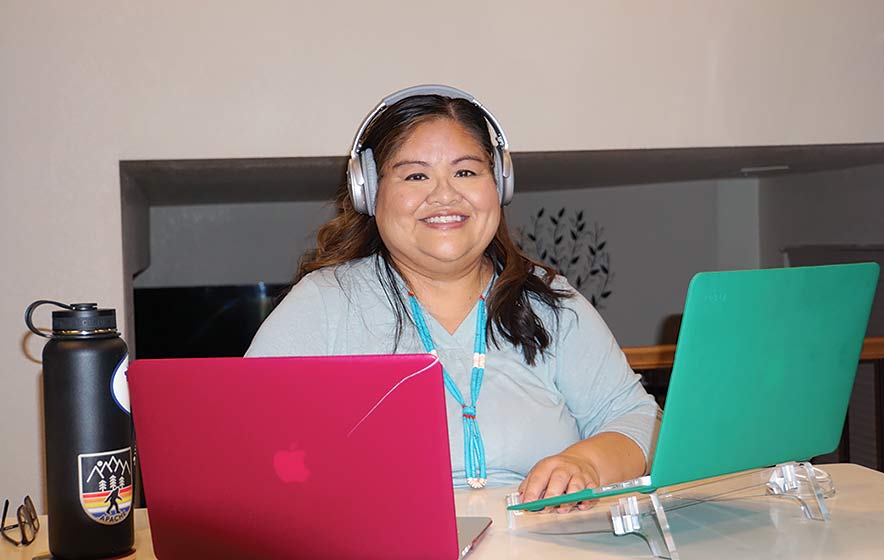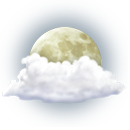
Making calls, saving lives: A week in the life of a contact tracer

Courtesy photo
Sasha Hoskie is a contact tracer for Sage Memorial Hospital. She works remotely from her home office in Denver.
CHINLE
The pandemic has come with its own lexicon.
Within the past year, “PPE,” “N95,” “social distancing,” “comfort baking” and the admonition of the year, “Mute yourself!” have, shall we say, gone viral.
There’s also the world’s newest career: contact tracer.
In every state and federal plan for containing the coronavirus, this role is emphasized. But what exactly do contact tracers do?
It’s a lot more than just calling COVID-positive folks and asking them where they’ve been and whom they’ve been in contact with, according to Sasha Hoskie, a Diné contact tracer and team supervisor who lives in Denver but works with folks on the Navajo Nation.
Her week generally starts Saturday. Hoskie enters her home office, equipped with a phone, two laptops and a desktop computer — one open to Zoom for meetings with her supervisor or the other contact tracers on her team, one with a spreadsheet of cases she’s working on, another for inputting information she gains from the calls she makes.
She starts with a list of people to call. Some have recently tested positive for COVID-19 or been in contact with someone who has, but others have been isolating a while and just need to be checked up on.
“I ask them if they have any needs, like food or medicine,” she said. Each contact tracer has a list in front of them of all the public and private resources available for COVID patients, and the team keeps in touch in case someone has heard of a new one.
Some people want to talk, and Hoskie lets them, although she tries to limit her phone time with each person so she can get through her list.
Some people definitely don’t want to talk. It’s not uncommon to be hung up on.
“I don’t take it personally,” Hoskie said. “I have to remember that they’re sick, that they just got some bad news (that they’re COVID-positive). Some are in denial.”
As a public service, the Navajo Times is making all coverage of the coronavirus pandemic fully available on its website. Please support the Times by subscribing.
How to protect yourself and others.
Why masks work. Which masks are best.
Resources for coronavirus assistance
Eventually, she said, most people realize they need help, and the next time she calls, they’re a lot softer. Some even apologize for their initial behavior.
Her Navajo language skills have gotten a workout as Hoskie explains what it means to “quarantine” — stay in your home as much as possible while you await your test results — or “isolate” — no contact with other human beings, even those within your household if you can’t go to an isolation center, except to bring you food and necessities. The latter is for those who have already tested positive and are at risk of spreading the disease.
“Some people just don’t understand that it means you don’t see anyone, period,” Hoskie said. “If they tell me they just went to visit a relative, I just have to be patient and explain it again.”
She also listens carefully when the patient speaks.
“If they seem short of breath or they’re coughing so hard I can’t understand them,” she said, “I’ll urge them to go to the hospital. Sometimes we even end up calling an ambulance for them.”
The morning Hoskie spoke to the Navajo Times, for example, she called a young COVID-positive woman who reported she was having chest pains. She was debating whether or not to see a doctor.
As calmly as possible, Hoskie told her she definitely needed to go to the hospital immediately.
She then called the hospital and advised them that a COVID-positive patient was coming in who may also need emergency care, and shared what medical details she knew so they could prepare.
She may have saved a life, and it wasn’t the first time.
“Until I got this job, I never was in a position to save someone’s life,” she said. “Since I started in May, I’ve probably saved several. You can’t ever define that feeling.”
This rewarding but high-pressure job isn’t for everyone.
“It’s high-turnover,” she said. “You have to really make sure you take care of yourself.”
Her team meets daily for updates and checking in. If you really need time to recharge, you can take it.
“You’re in charge of your own day,” Hoskie explained.
For Hoskie, who admits to being “a little bit OCD,” an inviting workspace is key.
She makes sure everything is clean and orderly. She plays calming music, and her two German Shepherds, Kona and Tina Fey, are never far away.
“They sometimes interrupt the Zoom meetings,” she admitted, but they’re as much a part of her support system as her co-workers.
You also have to be flexible to be a contact tracer.
“It’s a brand new job, and it’s changing daily as we go along,” she said. “You have to be willing to change with it.”
According to the Navajo Nation Epidemiology Center, there are currently 286 contact tracers on Navajo, which means, with 7,098 active cases as of Monday, each tracer has an average caseload of just under 25, which is way too many. Ideally, the center would like to have five contact tracers for every new case.
Gallup-based Community Outreach and Patient Empowerment is looking for more tracers to lighten the workload, replace those who quit and make sure everyone gets traced.
“We’re in a surge right now,” explained Hoskie, “so if you’re (COVID) positive and you haven’t been called, it may be a few days.”
Each patient also has a case manager and often a social worker and other support staff assigned, so the tracer isn’t the patient’s only lifeline, Hoskie explained.
Contact tracers are trained, procured and paid (or not – some volunteer) by different entities around the country. Hoskie’s team was trained by Johns Hopkins University and is a partnership between Partners in Health, COPE, the Indian Health Service and the individual hospitals.
Hoskie started out working with Gallup Indian Medical Center and is now assigned to Sage Memorial Hospital in Ganado.
“I really loved working with GIMC and I love my mentor, Dr. (Sonya) Shin, but I’m really enjoying Sage too,” she said. “It’s much smaller and I feel like the whole staff is our team, while at GIMC we were kind of a unit unto ourselves.”
Working with medical personnel has been a big perk of the job for Hoskie.
“I’m just in awe of nurses,” she said.
But even more, the experience has made her proud to be Navajo.
“The strength and the love I see in these Navajo families, it’s just amazing,” said Hoskie, who is Tsi’naajinii born for Nakaii dine’e. “When I hear about how they’re supporting each other, without resources, even sometimes without running water and electricity … I know we’re going to get through this.”
Information: To apply to be a contact tracer or learn more, visit copeprogram.org or pihhealth.org








 Highway 264,
Highway 264, I-40, WB @ Winslow
I-40, WB @ Winslow